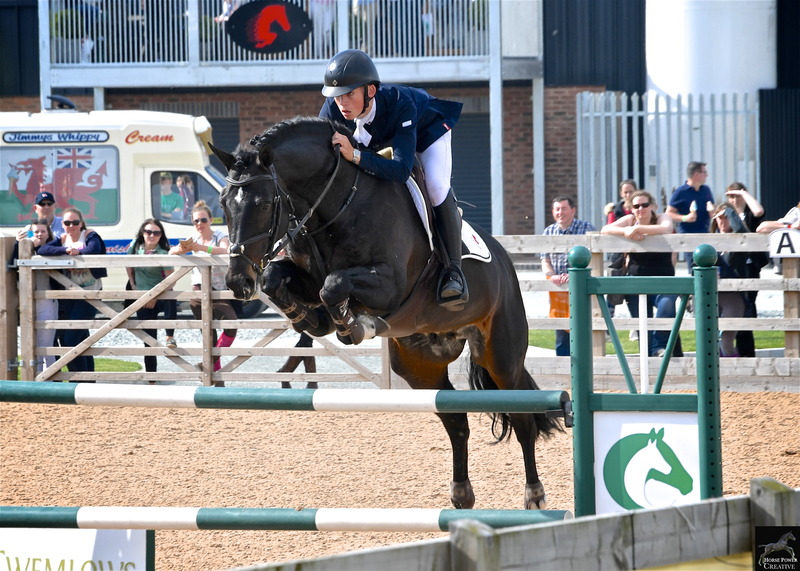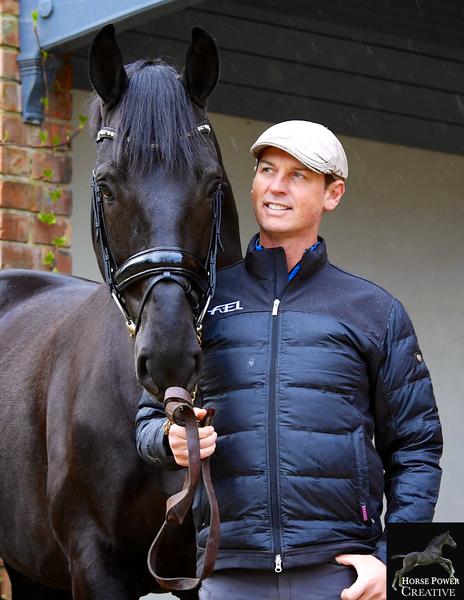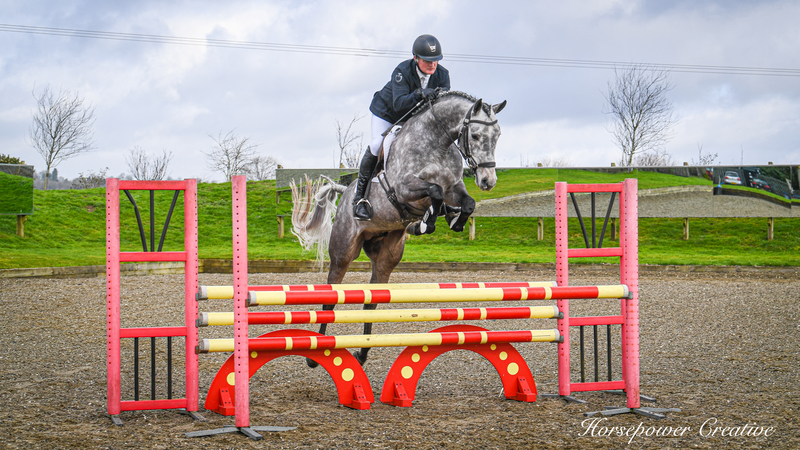Characteristics of AES UK horses
The AES strives for the following ideal phenotype for a horse or FEI pony:
1. Has a good temperament with the ability to learn and the willingness to perform and is easy and pleasant to handle.
2. Has strong and sound limbs which promote long-lasting health, for performance at the highest level without pain or discomfort.
3. Has a correct conformation that allows for expressive movement and performance
4. Is harmoniously built, with long lines and a noble expression.
To support its breeding goals, the AES has defined separate breeding standards for each Olympic discipline of showjumping, eventing and dressage, as well as additional guidance for sports ponies.
These separate standards are based on the impact of individual phenotype traits on a horse’s functionality for the sport. At all inspection events (mare and stallion gradings and youngstock inspections) the phenotype of the horses and ponies is described in a detailed linear profile, which is compared against the relevant breeding standard described in discipline specific breed optima.
The AES carries out continuous evaluation and revision of the breed optima based on sport performance and other relevant data, including the ever -changing demands of the sport and the expectation of the equestrian population.
The linear score helps to create accurate, detailed, uniform and objective description of the AES breeding population, which in turn facilitates their thorough, consistent and accurate evaluation. This reduces the potential problems arising from subjectivity or personal preference of evaluators and increases the reliability of studbook evaluations.
In summary: the AES facilitates the breeding of sport horses - for show jumping, dressage and eventing - which are suitable for performing at top international level, more specifically Grand Prix level for dressage horses and show jumpers, FEI level for ponies and 5*/WEG level for eventers. The horses/ FEI ponies are capable of long-term performance at that level based on their good health, which is supported by a correct conformation, good movements and the ability and willingness to perform.

Characteristics AES Showjumpers
The AES is proud to be the highest-ranking UK based studbook in the showjumping studbook rankings of the international umbrella breeding organization, The World Breeding Federation for Sport Horses (WBFSH).
It achieved this position by promoting the breeding of horses with exceptional jumping ability and a brave, cooperative temperament. As a result, an AES showjumper does not only have excellent scope and technique over a fence, they are combining these attributes with physical soundness and longevity, supported by correct and strong limbs and conformation, and a cooperative and brave temperament. Above all, AES showjumpers are equipped with the physical and mental attributes required to allow them to carry out their work, and any level, with ease and enthusiasm, making them a perfect partner in the sport.
In the evaluation and selection of showjumpers for breeding, particular attention is paid to the canter, which must be powerful, balanced, and able to extend and collect without loss of impulsion to provide a solid foundation for jumping ability and to meet the performance demands of the sport.
Showjumpers
1. Conformation: Limbs
- correct, straight limbs, with particular emphasis on strong pasterns
- good hock angle to support strength and “push off” power
- good, strong feet that are not too small, with a good amount of heel
- straight moving front legs to support optimum weight and impact distribution on landing
2. Conformation: Frame
– is harmonious, preference is given to a rectangular model
– has long lines and long legs to promote athletic ability
– has a slightly uphill build to promote balance
– has a long, arched neck, set on slightly high with excellent, correct muscling
– has a strong back and strong loins with excellent muscling
3. Movement
– The walk shows long strides with good shoulder freedom, is elastic over the
back with good activity, and has a correct four beat rhythm
– The trot shows a long stride with good shoulder freedom, elasticity and
impulsion combined with self-carriage
– The canter is powerful and balanced, developing excellent reach and freedom
from the shoulder and long, expressive strides and can lengthen and shorten easily without loss of balance or impulsion
4. Jumping
– The jump takes off in a slightly upwards direction, with speed and –
– The jump exhibits excellent bend in the foreleg, bringing it above the
horizontal and folding the cannon under the underarm
– The jump shows a rounded, arched back with a lowered neck and opening of
the haunches
– The horse jumps carefully and with a keen attitude, and has excellent scope,
with a supple back, a graduated trajectory
5. Temperament
– a brave horse willing to cooperate with the rider
– with a keen attitude towards jumping and showing excellent ability to learn
– easy to handle and reactive to aids
For a more detailed breakdown of the desirable phenotype traits in showjumpers, please refer to our breed optima recorded on our linear score sheets.

Characteristics AES Dressage Horses
The AES is the second highest-ranked UK based studbook in the dressage studbook rankings of the international umbrella breeding organization, The World Breeding Federation for Sport Horses (WBFSH), and is proud to have registered the highest ranked individual UK bred horse with ‘Into the Blue’.
The AES dressage horses are known for their correct movement, soundness and exceptional trainability. They benefit from three correct and active gaits with pure rhythm, excellent active hind legs and exceptional freedom and reach through the shoulder. In trot and canter they move effortlessly in self-carriage with natural balance and suspension. We are convinced that these physical attributes, which allow the horses to carry out their dressage work with ease and enjoyment, have a direct impact on the physical and mental wellbeing of our horses and assist in the breeding and production of a happy equine athlete. The goals of dressage is to teach to horse to use its body in a way that allows it to remain free of pain and carry out its work in harmony with the rider.
Dressage Horse
1. Conformation: Limbs
- correct, straight limbs, with a good pastern angle of 60 degrees
- good hock angle to allow self-carriage and long term soundness
- good, strong feet that are not too small, with a good amount of heel
- a very slight toe out behind to allow the hind leg to come straight underneath the body
2. Conformation: Frame
– is harmonious, preference is given to a rectangular model
– has long lines and long front legs to promote lift and expression
– has a decidedly uphill build to promote balance
– has a long, arched neck, set on high with excellent, correct muscling
– has a strong back and strong loins with excellent muscling
3. Movement
– The walk shows good shoulder freedom, is elastic over the
back with good activity, and has a correct four beat rhythm with a clear ‘V’
formed by hind and front leg. The strides are long, but not excessively so,
to allow collectability.
– The trot shows a long stride with excellent shoulder freedom, elasticity and
impulsion combined with self-carriage. The movement is elastic and free
from tension. To ensure longevity and soundness, the trot needs to retain
a clear 2 beat rhythm and while we encourage an active front leg with
excellent flexion, front and hing leg must work as a pair and the power
must come from behind.
– The canter is powerful and balanced, developing excellent reach and freedom
from the shoulder and long, expressive strides and can lengthen and shorten easily without loss of balance or impulsion.
4. Temperament
– a very willing horse, highly reactive to the rider’s aids without becoming too stressed or “hot” in a performance setting
– showing excellent ability to learn and to retain focus
– easy to handle
For a more detailed breakdown of the desirable phenotype traits in dressage horses, please refer to our breed optima recorded on our linear score sheets.

Characteristics of AES Eventers
In 2020, the AES was the highest-ranking UK based studbook in the eventing studbook rankings of the international umbrella breeding organization, The World Breeding Federation for Sport Horses (WBFSH).
AES eventers enjoy an excellent reputation for braveness and ability in eventing. Often with a high percentage of thoroughbred influence, they cover the ground at speed, combined with exceptional jumping ability and three correct, expressive gaits and the ability to move in self carriage and with impulsion. Above all, AES eventers are bred in close cooperation with the sport to select horses whose temperament allow them to enjoy the variety and the challenges of eventing and whose correct conformation and strong limbs allow them to compete free from pain or discomfort.
Successful eventers combine many of the qualities we desire in dressage horses and showjumpers, with an addition ability to cover the ground in a gallop and an exceptional, courageous temperament to meet the challenges of the sport. The demands of eventing are such that particular care is taken in the selection of horses not only with excellent ability, but also durability and soundness.
The contribution of suitable English Thoroughbreds and Anglo-Arabs is regarded as positive for eventing breeding, which is why the inspection of full thoroughbred stallions and mare with the intention of cross breeding them to warmblood and sport horse types is encouraged.
Eventers
1. Conformation: Limbs
- correct, straight limbs, with particular emphasis on strong pasterns and clean joints and tendon sheaths
- good hock angle to support strength and “push off” power
- good, strong feet that are not too small, with a good amount of heel
- straight moving front legs to support optimum weight and impact distribution on landing
2. Conformation: Frame
– is harmonious and not too long in the back to promote strength and durability
– has enough length of leg to develop speed, while still allowing for durability
– has a slightly uphill build to promote balance
– has a long, arched neck, set on slightly high with excellent, correct muscling
– has a strong back and strong loins with excellent muscling
3. Movement
– The walk shows good shoulder freedom, is elastic over the
back with good activity, and has a correct four beat rhythm with a clear ‘V’
formed by hind and front leg. The strides are long, but not excessively so,
to allow collectability.
– The trot shows a long stride with excellent shoulder freedom, elasticity and
impulsion combined with self-carriage. The movement is elastic and free
from tension. To ensure longevity and soundness, the trot needs to retain
a clear 2 beat rhythm and while we encourage an active front leg with
excellent flexion, front and hing leg must work as a pair and the power
must come from behind.
– The canter is powerful and balanced, developing excellent reach and freedom
from the shoulder and long, expressive strides and can lengthen and shorten easily without loss of balance or impulsion.
4. Jumping
– The jump takes off in a slightly upwards direction, with speed and –
– The jump exhibits excellent bend in the foreleg, bringing it above the
horizontal and folding the cannon under the underarm
– The jump shows a rounded, arched back with a lowered neck and opening of
the haunches
– The horse jumps carefully and with a keen attitude, and has excellent scope,
with a supple back, a graduated trajectory
5. Temperament
– a highly courageous horse willing to cooperate with the rider
– with a keen attitude towards jumping and showing excellent ability to learn
– easy to handle and very reactive to aids
For a more detailed breakdown of the desirable phenotype traits in eventers, please refer to our breed optima recorded on our linear score sheets.
Characteristics of AES Sports Ponies
AES sports ponies share the breeding goals of the AES horses in being able to perform and excel in jumping, dressage and eventing. Like in the horses, temperament and trainability are of utmost importance, and like in the horses, it is the AES philosophy to emphasise that ponies whose ability and conformation will enable them to carry out their riding career with ease and enjoyment will also be of sound mind and excellent temperament to make for a reliable partner for younger riders.
The ponies are evaluated using the same linear profile traits and breed optima as the performance horses to develop a clear AES sports pony type that is consistent with the AES breeding goals and philosophy.




